Susan Wright, president of the Theology & Peace board, was interviewed by Adam Ericksen of the Raven Foundation: A Discussion of the Upcoming Theology & Peace Conference: “Embracing We-centricity: Practices to Nurture the Common Good,” May 22-25 in Chicago. Below are the responses Susan wrote in response to Adams questions:
Adam: How did you first come across mimetic theory?
Susan: I audited a course in New Testament at Syracuse University taught by a then grad student in religion, Tony Bartlett. Tony was writing his doctoral dissertation which later became his first book, Cross Purposes. I remember well the day Tony introduced me to Mimetic Theory. I accompanied him and his wife Linda on a trip to Washington DC to visit Gordon Cosby and Church of the Savior. On the car ride down I shared with Tony and Linda my recent disillusionment as a community activist: that too often the work we were engaged in was undermined by internal rivalry. It was then that Tony told me about Rene Girard and Mimetic Theory.
Shortly after that Tony introduced me to his doctoral advisor, which happened to be James Williams. Jim gave me some books by René Girard and Raymund Schwager, including The Girard Reader. We spent hours discussing those books, as well as Dostoyevsky, and Thomas Merton. I was very lucky, I received in an intensive course in Mimetic Theory from one of René Girard’s closest academic associates.
Adam: Why is mimetic theory important to you?
Susan: I was the child of a teenage mother. Single and living on welfare, my mother had three children by the time she was twenty years old. Born into that situation, my sisters and I had a very difficult childhood. We experienced things children never should. Before I could even read, I discovered a cruel reality — that when confronted with suffering or injustice most people look the other way. Those few people who do help, they make all the difference!
The truth is, there are negative consequences to living in a free society where everyone is preoccupied with their own lives. Paul Dumouchel one of the best political theorists working with Mimetic Theory, explains that the moral distance, the space between us and our obligation to others, has become maximal. The social networks, which once induced people to care for those within their social group, have disappeared. “We have no reciprocal obligations with respect to one another, except perhaps with respect to family members and close friends. We are free with respect to one another. This is why we can be indifferent to the fate of others….” (The Barren Sacrifice, 27) We’re aware that thousands of elderly are abandoned to nursing homes, we’ve heard the statistics about the mass incarceration of black men, we know that poverty is on the rise, we know that there are millions of displaced refugees living out the worst kind of nightmare… but because we’re not obligated to do anything about it… because we’re busy with our own lives… as long as it has no direct impact on me, for the most part, we ignore it.
By the time I was eighteen I was haunted by a negative image —- an abyss at the core of American society. I wondered, how is it possible that in the wealthiest nation on earth, a democratic nation founded on the ideals of justice, freedom, and equality that the most vulnerable people, children, teenage mothers, the elderly, the mentally ill and impaired, people of color, and immigrants are allowed to fall through the cracks and disappear into oblivion? Already as a young person I was bitterly aware of the contradictions haunting our corporate life.
Because of financial aid, I went to college. I majored in history, but I also took courses in political science and anthropology… I needed answers. But the more I learned the sort of things they don’t teach you in grade school, the more it deepened my existential crisis. After college, I turned to activism, to building alternative economic communities grounded in social justice. Despite everything I still believed in democracy, in a sense democracy was my religion, it still is.
I wasn’t raised with religion, but in a secular environment where theology was pretty much a bad word. The adults that raised me were liberated from so-called superstitious thinking, they were willing to admit that Jesus was a good man, but beyond that they had no use for Jesus or his religion.
When I was twenty, quite accidentally, I picked up the bible and read John’s Gospel… I can’t tell you the impact it had on me… I was reading all the time… at that time it was Thomas Hobbes, and the Enlightenment thinkers, searching for answers, I encountered in the bible a concern for the weak, the poor, the outcasts that I had rarely, if ever, experienced in my day to day reality. Even so it wasn’t until my encounter with Mimetic Theory that I decided to become a Christian, to join the Episcopal Church and go to seminary. Today theology and Mimetic Theory comprise a large part of my life’s work.
Mimetic Theory was a game changer, because it gave me the language not only to identify the WHY of what’s wrong with American society, it gave me a practical methodology that cuts deep enough to address it, to formulate answers.
I first read Deceit, Desire, and the Novel, Girard’s break out book, which was published in French in 1961. I’ll never forget reading the title of the first chapter, “Triangular Desire…” It introduced me to the world of mimesis, that is, imitated desire. Girard, a literary theorist, realized what the great novelists intuited that they, like the characters in their novels, were trapped within desire’s mimetic web. They experienced a kind of conversion, a point in their writing when they could no longer heroize the myth of spontaneous desire, but instead revealed in their works that all desires are borrowed. We do not chose for ourselves the objects of our fascination. We desire those objects because they are first desired by another.
It’s such a great read! Girard describes in fascinating detail the mimetic intrigues and passions which take hold of our lives: the love triangles, the disastrous rivalries, the hidden resentments we harbor, and the moments of transcendence. The long and short of it is: whenever two or three are gathered, mimetic desire presents a significant challenge to peaceful coexistence. Imitated desire leads to competition over objects. Competition over objects erupts into a contagion of rivalry and reciprocal violence. Reading it, I immediately made connections to dynamics which undermined our activist work. It would apply to any work situation, to our church communities — it’s the best manual I’ve read for understanding our human interaction.
Over the course of his subsequent books, Violence and the Sacred (first published in 1972) and The Scapegoat (first published in 1982), Girard develops an incredibly useful hypothesis on the origins of culture. (I say hypothesis because we’ll never really know what happened way back there at the dawn of time). He describes a prehistoric scene, when our ancestors, in a fit of violent mimesis, channeled all the reciprocal aggression threatening to engulf the community onto a single individual, someone expendable to the group. What then becomes a mimetic convergence of all onto a single victim provides cathartic release. The community is delivered from the disastrous effects of it’s own violence, in what would have felt like a miraculous moment. They’ve been saved!
But there’s a catch, the community can’t admit to having just scapegoated someone… that would deprive them of the peace just miraculously received. Prehistoric communities reenacting that original moment in sacrificial rituals repackaged it in mythological stories in which the gods’ demand the sacrifice… Today we dehumanize the scapegoat, rationalizing their treatment as necessary to protect our own safety.
That, for Girard, is the birth of the violent sacred and the foundation of culture. When we read ancient texts or look at the archaeological record, it becomes very clear that the fear of violent contagion led archaic societies to contain mimesis and its effects through prohibition and ritual. That is, strict rules regulating desire paired with rituals to redirect violence onto a sacrificial vicim. MT clarifies why, with the advent of modern nation states, citizens willingly relinquish power, most notably the right to seek retribution, recognizing the state as the only legitimate force. If some one, whose envious of their neighbor, kills their neighbor and steals their stuff, they’ll be punished by the state. The state liberates its citizens from the fear of violent contagion. In a democratic society, this leaves us free to pursue our desires, it unleashes consumerism on a massive scale… we can imitate each other without fear of conflict… and imitate each other is exactly what we do!
Freedom to pursue our desires sounds great, doesn’t it? Except we must never forget that modern nation states are founded upon systemic scapegoating and continue to achieve peace by redirecting internal tensions onto scapegoats.
Mimetic Theory equips us with a powerful diagnostic tool. It allows us to deconstruct the lies which have rationalized the worst political crimes: the extermination of indigenous people, following the Civil War Jim Crow laws in the south, today the War on Drugs and mass incarceration. And it explains why in the United States of America, we have a history of blaming the weakest members of society for their plight, as if it has ever been a fair playing field, and how politicians to this day are able to wield the scapegoating of the weak as a rallying point.
MT can play a significant role detecting those instances, like now, when America is tempted — let me reframe that — when America may be mimetically induced to scapegoat again. In his book Violent and the Sacred, Girard sheds an uncanny light on politics: sometimes we choose leaders not for their high moral character but for their willingness to name scapegoats upon whose head we can discharge all our internal tensions.
All of this sounds so depressing. Yes, it is. People get angry when you for challenge the myth that America can do no wrong. In my case I wasn’t being stripped of any cherished notions about my beloved homeland. Years of activism had already deprived me any naive idealism… I had experienced so much rivalry within the peace and justice community. In my mid-thirties I had to quit activism for awhile, I was exhausted… that’s when I met Tony Bartlett and Jim Williams… it couldn’t have been better timing. Reading Girard for the first time, one book after another, I felt like someone who, after years of wandering lost in the desert, had just been handed a road map.
In Things Hidden Since the Foundation of the World (published in 1978), Girard reading Hebrew and Jewish scriptures, discovers that these texts are shaped by an awareness of mimesis, of rivalry, the various authors of the Hebrew texts understood, in one sense or another, the threat of violent contagion and our proclivity to scapegoat. Out of their own context of suffering, those writers developed a unique sensitivity to the plight of the victim. The Hebrew and the Christian texts may be read within the struggle to get free of our reliance on scapegoating. Now that was a revelation! Something that matched my own experience and answered a deep longing in my own heart.
When I eventually returned to activism, I did so with the awareness that we’re all mimetic creatures, prone to selfishness, rivalry and scapegoating… rather than walk away in disillusionment, I now recognize that that’s starting place from which our real work begins.
I haven’t lost hope or my belief in democracy… I still love my county. Hope forged out of a realistic understanding of what’s wrong does not abandon you when things get rough. In moments of setback you make use of what you learned, you steer clear of the the crowd intent on scapegoating and you seek another witness, a better option for people to gravitate to.
The way I see it, human beings, both individually and collectively, lack self-awareness… that is the root of our evil. To paraphrase Jesus on the cross, we know not what we do. They need to be given a better set of options.
Adam: What is the mission of Theology and Peace?
Susan: Theology and Peace was formed ten years ago by Tony Bartlett, a professor of theology at Bexley Hall, the then Episcopal seminary in Rochester NY, Michael Hardin, the director of Preaching Peace, and Tom Nicoll, an Episcopal Priest in Larchmont, New York. At this year’s conference we’ll celebrate our tenth anniversary! At the time they recognized the need for a forum where we could focus unapologetically on the implications of Mimetic Theory for Christian theology and praxis. COV&R, the Colloquium on Violence & Religion, the academic organization founded over 25 years ago invites scholars from diverse disciplines to discuss the continued application of MT in their various fields. A number of us on the board are members of COV&R. Theology & Peace invites pastors, lay people, theologians and activists to explore what many of us have discovered: that Mimetic Theory provides a much needed source for the renewal of Christian discourse and it’s engagement in the world. We host an annual conference. This year it will be held May 22-25 in Chicago. We host ongoing forums on our website and on our Facebook pages.
That’s where we started. Over the course of ten years our mission has evolved… our engagement with Mimetic Theory has drawn us into places we might not have otherwise ventured. Like Jesus, we’ve gone to the place of crisis. We tend to host our conferences in cities where the violence is front page news: in 2013 & 2104 we went to Baltimore, in 2015 & 2016 we gathered in Raleigh North Carolina just as the Moral Mondays protests were getting underway. This will be our third consecutive year in Chicago.
Looking back, I realize that in 2011 Theology & Peace made a signifiant decision, what I like to term our turn to the issue of racism. That year we chose to go to Baltimore. Board members Tony Ciccariello and Anthony Bartlett sought out personal connections in Sandtown, the neighborhood which, a few years later, erupted in protest after the death of Freddie Gray, a member of the Sandtown community who died while held in police custody. There Tony C and Tony B encountered Newborn Ministry and Elder CW Harris and Wendall Holmes, leaders of that community. Since then members of the Sandtown community have been important contributors to the work of Theology & Peace.
In 2013, planning our 6th annual conference, the Theology & Peace board made another important decision which had a profound impact on our collective sense of our mission. Despite some hesitation and a bit of trepidation the board chose a conference title which included the word: “Lynching” — “Lynching, Scapegoating & Actual Innocence.” There were concerns that that word was too strong and would scare people away.
Last year was the fourth year we addressed the issue of racism. And we’re not finished. Having shared conversations with black theologians, community activists, and people on the inside of the justice system, we’ve gained a tangible sense that we can change our “collective intentionality” (a term I got from psychologist Ann Kruger, one of our presenters in Raleigh) not just in our church congregations, or in our activist communities, but at the very heart of the sacrificial system — our justice system, beginning at ground zero so to speak, with encounters between people and police in our American cities, where intentionality has been left to chance and police and people are ill equipped to respond to each other in heated moments of conflict, when all the accumulated trauma, fear and tensions accumulated over this country’s history of racism reach the flash point and erupt. This is one area in which the practical application of Mimetic Theory could create real change.
Part of our mission is to challenge the status quo, especially the assumption that systemic scapegoating is too entrenched… for instance: racism’s appearance of intractability, forms part of the collective lie which allows the American people to maintain their anonymity — “I’m not a racist.” — “I hate racism, but I can’t begin to change such a deeply entrenched structure.”
Mimetic Theory helps us identify the ways that this nation is founded upon the scapegoating of black people, especially young black men. We recognize the historical stereotypes of blackness, black men which today is perpetuated by the media as means for designating an entire population as scapegoats. Likewise, it’s equally important that we don’t demonize those working in the justice system. We understand that those caught in the cross fire, so to speak, both the people and the police, are victims of this nation’s collective violence.
As Mimetic Theorists and readers of René Girard, Theology & Peace brings an important element to the discourse on race, the question of immigration, the refugee crisis, Christian/ muslim relations. In response to these crises, we, through practices that cultivate of self-awareness, an opportunity to back away from our collective tendency to scapegoat and create an alternative witness.
Adam: The name “Theology and Peace” is a great name for the organization. The words theology and peace seem like they are obviously connected. But for an organization to make the connection in such an obvious way, maybe the connection isn’t so obvious. The leads me to a two-part question – First, how has theology been connected to violence? Second, how can Theology and Peace help us into a more peaceful theology?
Susan: So many people are abandoning religious institutions because theology not only feels like a dead language with no practical applications for their lives, it is hopelessly implicated in a history of bloodshed. There’s no denying it, theology has produced some of humanity’s greatest evil, but it is also responsible for some of the greatest good. The same can be said about the word “Peace.” A lot of evil has been committed in the name of Peace, in the name of God, in the name of Freedom, Justice and Democracy. Nevertheless we need these words, because, as one of my favorite philosopher/theologians John Caputo says, they continue to place a demand on us.
Mimetic Theory allows me to distinguish, in a sense, between a good peace and bad peace (but not in any fixed dualistic sense), that is, between a peace that’s established through some sort of scapegoating, like the peace between Pilot and Herod, and a peace that is trying its very best to free itself from scapegoating. The same can be said of God: we can distinguish between angry spiteful images of God, and a loving, compassionate image of God, concerned with the plight of the victim. In fact theology can become the study of the difference between these various images. Why do we choose one over the other? How do we free ourselves from our reliance on the retributive god? To the extent that we engage with a theology founded in the image of a compassionate, loving god concerned for the weak, the more we find ourselves transformed by that image, becoming that image for others. So in a sense, I feel we need to redeem those words, Theology & Peace, put them back into play in a truly fruitful way. I can’t think of any other words I’d rather use.
Adam: Justice is also a major theme within theology and peace. Desmond Tutu once claimed that “… peace without justice is an impossibility.” Yet, Rene Girard rarely talked about justice. What do you think is the role of justice in creating peace?
Susan: The nations always seek peace. But too often peace comes at the at the expense of the weak, the vulnerable, or someone different from us. Powerful nations and their leaders sign treaties and call it peace, they may even call it justice, but if it doesn’t build a peace that includes all members of a society, if it doesn’t show mercy on all sides, it is a violent, unjust peace. When I think of justice I think of Zechariah 7:10:
Thus says the LORD of hosts, ‘Render true judgments, show kindness and mercy each to his brother, do not oppress the widow, the fatherless, the sojourner, or the poor; and let none of you devise evil against his brother in your heart.’ But they refused to hearken, and turned a stubborn shoulder, and stopped their ears that they might not hear.
And Matthew 25:45 comes to mind:
‘Truly, I say to you, as you did it not to one of the least of these, you did it not to me.’
A peace built on scapegoating is not a lasting peace, an economy that does not benefit all the members of society, is not sustainable, at some point the violent structures collapses upon themselves. Girard saw this. In Zechariah, because they refuse to listen the people are scattered and the nation is left desolate. Whatever your cosmology might be, Girard understood that there can be no rest, no true enjoyment of this world or the next, until we give up our sacrificial systems in the here and now.
Justice requires that we invite everyone to the table, including our enemies. We can be angry with Donald Trump, but it’s important that we recognize his humanity and treat him with respect. We need to change the culture which accepts the name calling in the media and back and forth accusation as normal… Mimetic Theory understands that accusation iniates the unconscious dymanics I described earlier, which trigger the lynch mob mentally. Our brains are habituated to recognize those cues… before you know it, people are converging on a victim. We can access other neural pathways in our collectively wired brains, pathways responsible for compassion and empathy, cultivate those by stretching ourselves in new directions. This requires we steer clear of accusation and find other ways to repond to those we disagree with. We must quiet our fear reflex and invite Muslims, immigrants and refugees to the table. Can you imagine what it feels like to be a young person growing up in an immigrant family… what would it do to your self concept to hear the ugly accusations made in the media, made by public officials?
And while in the current context it appears we’re headed as a nation in the wrong direction, I still believe that history does not have to repeat… there is still a chance to respond to the demand for justice and mercy, to dream the dream of democracy!
Adam: What is the theme of this year’s conference?
Susan: “Embracing We-Centricity: Practices that Nurture the Common Good.” I believe the neuroscientist Vittorio Gallese coined the term “We-Centricity” to describe our inherent openness to the other.
…every time we relate to other people, we automatically inhabit a we-centric space, within which we exploit a series of implicit certainties about the other. This implicit and pre-theoritical, but at the same time contentful state enables us to directly understand what the other person is doing, why he or she is doing it, and how he or she feels about a specific situation. (Vittorio Gallese, “The Two Sides of Mimesis,” Mimesis and Science, 100.)
I don’t know how any of us can still believe in the myth of individual autonomy. Vittorio Gallese, one of the neuroscientists to discover mirror neurons, and connect that discovery with a theory of Social Cognition (how we understand each others’ emotions, intentions, and desires) has used this same research to identify the brain structures responsible for mimesis.
According to Gallese and others we are wired for mimesis. From the moment of birth, the human brain, through the observation, interpretation, and imitation of others’ actions, is ever grasping for opportunities to learn the skills necessary for life. That means, for good or for bad, we are inescapably connected to each other. There is no such thing as the autonomous individual.
Some may say that our conference theme and our name, Theology & Peace, sound naive… but really they’re not. In a funny sense that’s the key to our work. Mimetic Theory allows us to recognize why we-centricity is always problematic…why the common good, has historically bad thing for those being excluded — if left to our unconscious collective dynamics our inherent we-centricity leads to scapegoating … then it’s violent. However, in recognizing this, in understanding how our tendency to scapegoat infects so much of what we do, we can turn that understanding to build communities intentionally seeking to get free of scapegoating, then we-centricity and the common good become a positive goal. In a sense it’s an impossible vision, but it’s the only vision really worth having. Others have shared that vision, they’ve given everything for it: Jesus, Mahatma Gandhi, Mandela, Oscar Romero — just being in their presence, hearing their words — we get a sense that a common good is a possibility out there, beckoning us. Those individuals keep opening the door to that possibility, inviting us to join them.
Adam: Who are the speakers and what will they be speaking about?
Susan: All of our speakers will engage us in practices to essentially rewire our brains. To train in us new habitual ways of being together. Who says it? Maybe it was Cynthia Bourgeault “Neurons that fire together wire together,” a phrase borrowed from Donald Hebb, a Canadian neuropsychologist.
For our first plenary session Theology & Peace board member, Sereta Richardson, will present on Circle Processes. Sereta is a young black woman, a single mother, and an ex-police officer from Mississippi. She is one of the most eloquent spokespeople for Mimetic Theory that I have yet to meet. I would guess that her eloquence is born of life experience. I think she’s our youngest board member, but she may be the wisest. She will set the stage for this year’s conference by leading us in Circle Process. Leaders in Circle Process draws on the ancient Native American tradition of the talking piece and combine that with concepts of democracy and inclusivity. It utilizes powerful images to invite us into inclusive community structures:
Our ancestors gathered around a fire in a circle, families gather around their kitchen tables in circles, and now we are gathering in circles as communities to solve problems…
Recommended Reading: Kay Pranis, The Little Book of Circle Processes: A New/Old Approach to Peacemaking ( New York: Good Books, 2005). A title in The Little Books of Justice and Peacebuilding Series.
Brian Robinette and Father Martin Laird will lead us in a session on Contemplative Practice. Brian Robinette is Associate Professor and Co-director of the Joint MA in Philosophy and Theology at Boston College. In my mind he is one the most important thinkers working with Mimetic Theory who has thought and written extensively about the Christian contemplative tradition in light of Mimetic Theory. I’ve heard Brian speak before. He never fails to offer the most amazing insights:
When we turn our gaze inward, we can learn to recognize all the forms of desire within us!
The contemplative life is not opposed to the active life, it is freedom from the reactive life.
By cultivating stillness we let go of our neighbor as mimetic hook!
Father Martin Laird is a Professor of Theology at Villanova University. He has extensive training in contemplative disciplines and gives retreats throughout the United States and Great Britain. I am very excited that Martin Laird will join us. When it comes to Christian contemplative practice and its ability to free us from the endless mill of suffering, from anxiety and depression — I think of Martin Laird.
Father Martin is the author of A Sunlit Absence: Silence, Awareness, and Contemplation (2011), Gregory of Nyssa and the Grasp of Faith (2007) and Into the Silent Land (2006). Into the Silent Land is one of my very favorite books on contemplative practice, a book I like to purchase and give away to friends.
This will be an incredibly important session. If you take for instance, Deceit, Desire, and the Novel, as your manual outlining all the ways mimetic desire hooks us and you pair it with contemplative practice as understood by Brian Robinette and Martin Laird, I would say, you’ve equipped yourself with probably the best practice to retrain your brain, to step back from many mimetic hooks we encounter on a daily basis and simply let them pass down the stream of conscious awareness.
Jonathan Brenneman present on Christian Peacemaking and activism. Jonathan is Coordinator, Israel/Palestine Partners in Peacemaking, Mennonite Church USA. He comes from a long line of Mennonites on his father’s side and a prominent Palestinian Christian family on his mother’s side. He grew up in a small town in Ohio. After attending Huntington University, where he studied History and Philosophy, he worked with Christian Peacemaker Teams Palestine (CPT) Project in Hebron. CPT’s mission is to build partnerships to transform violence and oppression. Jonathan worked on the ground with Palestinian and Israeli peacemakers, and organized in the USA to challenge oppressive Israeli policies. Most recently Jonathan completed a master’s degree in Peace Studies at Notre Dame’s Kroc Institute. That program included a six month internship with Ndifuna Ukwazi in Cape Town South Africa, an organization which advocates for more just land policies. He currently works for Mennonite Church USA, coordinating educational opportunities about Israel-Palestine.
Adam: What do you see as the role of Theology and Peace in our current cultural climate (Trump, politics, religion …)?
Susan: A year ago, this time, the Theology & Peace board recognized that whatever the turnout of the Presidential election, this country would be deeply divided. We are a nation sick with rivalry. While the political parties engage in what Girard terms a model-obstacle obssession with other, they’ve lost sight of the role the were commissioned for. No wonder an increasing portion of the electorate no longer feel that their elected officials, the government as a whole, nor the economy are working for their benefit. Indeed, the electoral vote, like any object of rivalrous realtionship, quickly disappears from sight as the rivlary between the political parties continues to intensify.
I’m not sure how I would react right now. I might despair if I didn’t have thinkers like René Girard, Paul Dumouchel, or postmodern philosopher Jacques Derrida (another thinker who is for me as important as Girard) to help me think my way through this crisis. But even more important how would I feel if I wasn’t part of a community, like Theology & Peace, which is trying to translate the wisdom cultivated from MT into actual practice? Our churches, our synagogoes, our work places, every place where two or three are gathered… can be that… a witness to a better way of being human together. My hope is that more people could come in contact with this…
Democracy is up against it limits, we all know it, but again it’s from that position that we can engage in the real work of creating an inclusive society. Anyone who has made strides in that direction, the political saints of the past, have done so there at the limit point.
In a world that is increasingly prone to pessimism and despair, we’re tempted to give up on democracy, on justice, on truth… leaders willing to scapegoat as a path to power will take advantage of the situation, it’s the perfect breeding ground for tyranny. In this climate we must continue to use words like democracy, freedom, liberty, justice, equality… I say that without hesitation. They are still the best words we have, the greatest dreams we dream. It’s our work with Mimetic Theory that allows me to say this, and I think I speak for everyone on the board of Theology & Peace. In all my years of activism, in the church, in divinity school I have never encountered a group of people more invested in those dreams… we’re in it for the promise that till beckons us —- that this nation can be “great” to the extent that it continues to responds to that call: “Give me your tired, your poor, your huddled masses yearning to breathe free…”
For sure, US history has a very checkered past: marked by genocide, by slavery, and imperialism we have so far to go in equal rights for all people. With the increasing divide betwen the rich and EVERYBODY else, more people are feeling that the American dream has gotten too far out of reach… So many of us who thought America was on an upward path, are feeling demoralized. Not to mention that false new has us left in a tail spin.
But Mimetic Theory has some tools to cope with this… it understands the untruth of the crowd (a phrase taken from Kierkegaard) Untruth is nothing new for those who’ve been maligned because of their race or creed. It’s difficult for white, middle class Americans to suddenly find themselves subjected to obvious lies. But again it’s the oldest game.
Girard always considered himself a realist. For him there’s nothing more real than the blood of the victim spilled on the ground. Not as a rallying point for revenge, but as a kind of reality check. Two summers ago when the body of Michael Brown, an armed black man, age 18, fatally shot by police, was left for four hours face down in the middle of the street, blood streaming from his head.… it doesn’t get more real that! The NY Times made precisely that point in this video https://www.nytimes.com/2014/08/24/us/michael-brown-a-bodys-timeline-4-hours-on-a-ferguson-street.html
What does that say about our nation? It speaks volumes.
We-Centricity becomes a positive reality, rather than a negative one, when we become aware of our deep seated tendencies to scapegoat, when we cultivate, through daily practice, our ability to step back from the mimetic dynamics that lead to scapegoating, so that at some point inclusivity becomes our habitual way of being together rather than opposite.
Mimetic Theory’s insights don’t end with diagnosis, it also teaches us that change doesn’t have to come from those in power… but most likely occurs through our connectedness. As Nelson Mandela taught us, it can come from within the mist oppressive structures, from those condemned to the status of the scapegoat… Mandela in his day to day responses to those who held him captive not only changed the “collective intentionality” of his prison community, he eventually changed the “collective intentionality” of an entire nation. That’s where it’s at!
Please register at Eventbrite: https://www.eventbrite.com/e/theology-peace-10th-annual-conference-embracing-we-centricity-tickets-21595441547











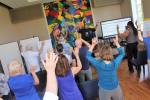







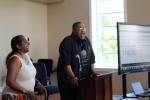





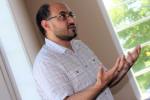
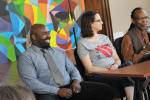



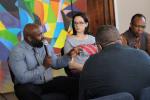


























hi-
I used to work with a man named Tony Bartlett many years a go at Buckden Towers in the UK. I would be pleased to re-connect with him, if your Tony is the same bloke!
regards,
Malcolm Wilson
LikeLike
Hi Malcom, I wrote to Tony. How can he get in touch with you?
LikeLike
Hi Malcolm I also rememberTony at Buckden Towers that seems a lifetime ago not sure you remember me I attended a fair few of those summer retreats in my youth and am now in my 60th year I remember those days like it was yesterday. I hope you are well it was a real surprise to see your name after all this time God bless David Clarke
LikeLike